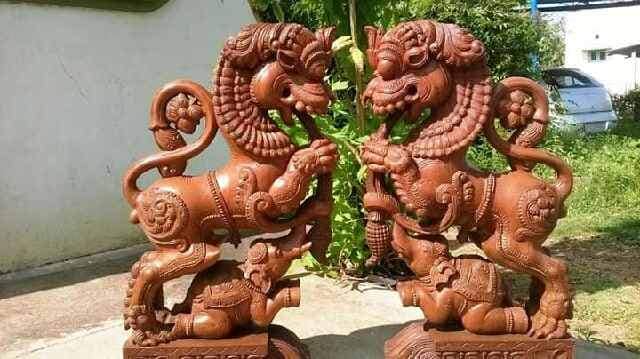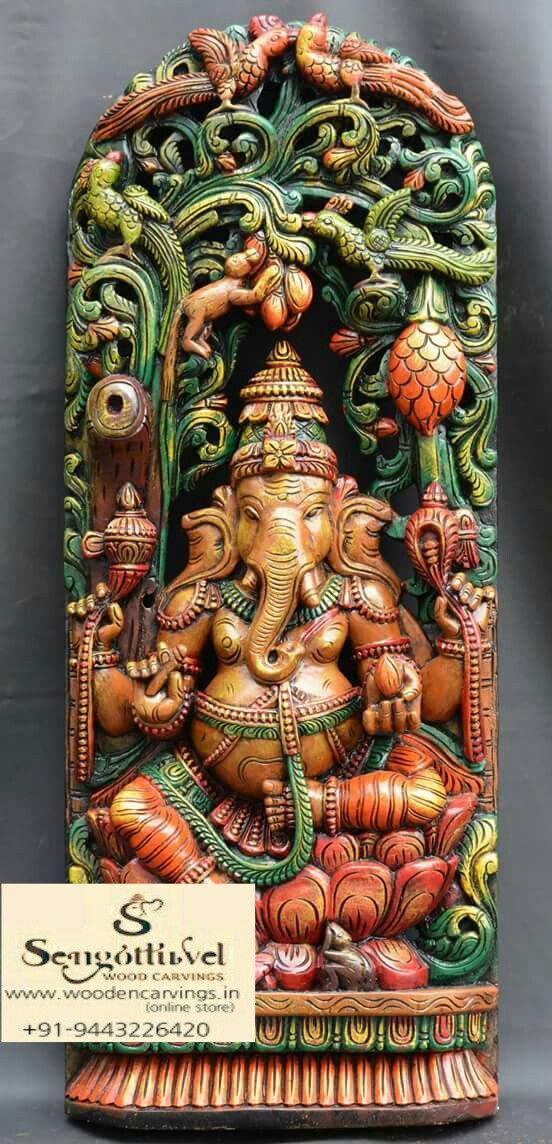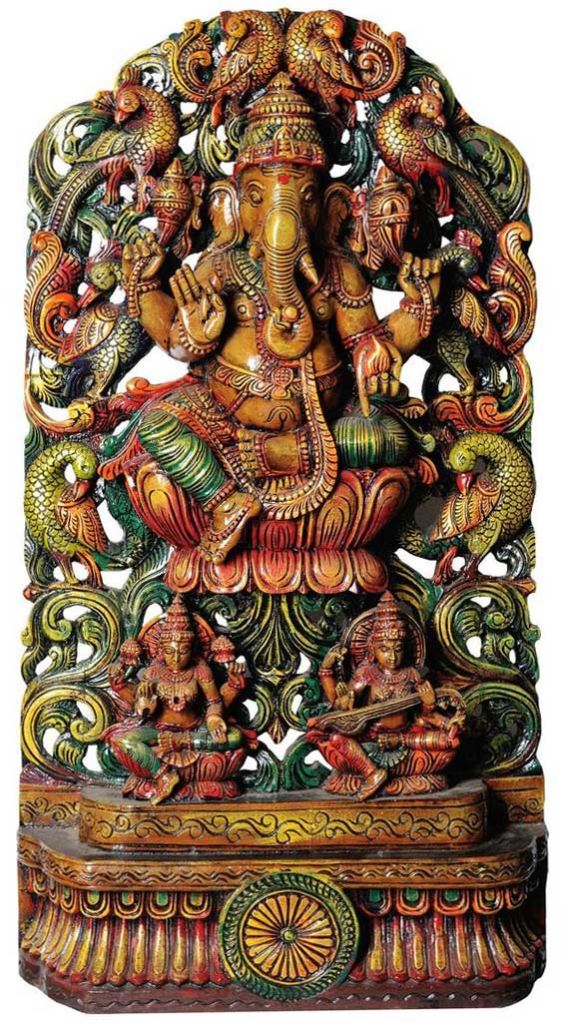ॐ श्री गुरुभ्यो नमः ॐ श्री शिवानन्दाय नमः ॐ श्री चिदानन्दाय नमः ॐ श्री दुर्गायै नमः
Source of all Images in this Blog-post : Google Images : ‘Google Image Search’ will reveal the multiple sources of every single image shared in this Blog. For more details, kindly see ‘Disclaimer‘

Thammampatti wood carving which is the signature artwork of the artisans in the Salem region of Tamilnadu, has become Tamil Nadu’s 36th Geographical Indication (GI) product.
It has been thriving in Salem area for more than 75 years. Thammampatti Shri Ugra Kathali Lakshmi NarashimhaSwamy temple car (chariot) was made by the artisans of Thammampatti in the year 1948.

Thammampatti wood carvings refer to the craft of wood carvings practiced by one of the highly skilled community of craftsmen on wood that is locally available in & around Thammampatti.

Samaneasaman (rain tree wood), country wood, Vaagai (AlbizziaLebbek), Mavilangai (CrataeveRoxbyrch) and Atti (FicusGlometrea) are the varieties of wood predominantly used by the sculptors of this region.
The artisans of the Salem region are skilled in this particular form of craft, and the craft is traditionally and hereditarily transferred from generation to generation.
Thammampatti wood carvings encompass a wide variety of motifs that were traditionally followed by the forefathers of the present-day craftsmen, and the skill of intricate technical knowledge has been passed down to the present generations of wood carvers by legacy.
The motifs & designs of Thammampatti woodcarvings are derived from the architectural details of Tamilnadu temples.
The main product range includes idols of Hindu gods, Hindu mythological stories, Dasavataraas, Vahanaas of Hindu gods, mythological creatures, door panels, temple doors, Puja Mandapams, temple chariots etc.
The size of the wooden statues varies from 2 ft. to 6 feet in height and of proportionate width with an antique finish.
The wood used to make these products includes Thoongavagai (Samaneasaman/ rain tree), Vaagai (AlbizziaLebbek), Mavilangai (CrataeveRoxburch), Atti (Ficusracemosa) & Pterocarpusmarsupium (Indian Kino).
The rain tree wood found in the agricultural lands tend to be in golden to dark brown color. It is durable and has medium to fine texture. The Vaagai tree is moisture tender and has a good natural lustre with a fine texture.

The Mavilangai tree is a wild or cultivated tree which is widespread in Thammampatti region and is found on glades, and near rivers and lakes.
The Atti tree is a large deciduous tree and grows to a height of 7-10 metres. It has smooth white bark which is best suited for ornamental purpose. Even teak wood & rosewood are used for making doors & door panels.

The wood carving craft practiced by the craftsmen of Thammampatti follows the specific rules and measurements of ancient Indian iconography known as ‘Shilpashastra’.
Thammampatti wood carvers are highly skilled in carving temple chariots.
The process of wood carving of this region is environment friendly with the minimum use and exposure to chemicals.
The seasoning of wood is done naturally by exposing the wood to different climatic conditions. The process is natural and is not developed under artificial conditions.

The wood carvings of Thammampatti are not just beautiful and unique but also has a fine human touch that has been passed down the generations.

Thammampatti is located in Gangavalli Taluk of Salem district between Pachaimalai and Kollihills in Tamil Nadu. It is situated on the banks of Swedha river. It is 63.4 Kms from the city of Salem.
Tamil Nadu’s Thammampatti wood carving to get GI tag :
Thammampatti wood carving, a signature work of artisans in the Salem region, has become Tamilnadu’s 36th Geographical Indication (GI) product.

The GI recognition for the unique wood-carved idols of Hindu gods, mythological stories, door designs, door panels and temple doors come after a joint application by Silpa Gramam Thammampatti Wood Carvers’ Artisans Welfare Association and Tamil Nadu Handicrafts Development Corporation Limited (Poompuhar).
As for the proof of origin and the history of the product, the GI Registry was informed that the ‘Oddar’ community of the region has attained mastery in this craft, and the intricate technical knowledge has been passed down to generations of wood carvers by legacy.
It has been thriving in the Salem area for more than 75 years, and the Thammampatti Shri Ugra Kathali Lakshmi Narasimha Swamy temple car was made by them in 1948.

The News : After seven long years, Thammampatti wood carvings of Salem to get GI tag :
The Thammampatti wood carvings of Salem carried out by a group of artisans of the region are all set to be granted the Geographical Indications (GI) tag.
After a gap of seven years, the GI Registry will grant the coveted status to the applicants Silpa Gramam Thammampatti Wood Carver’s Artisans Welfare Association and the Tamil Nadu handicrafts development corporation (Poompuhar).
Since there was no objection received for the application, the certificate will be issued once the lockdown is lifted said officials at the registry.
The wide range of wooden products that are being made in Thammampatti include idols of Hindu gods, mythological events or stories, Dashavatars, Vahanas, mythological creatures, door designs, door panels, temple doors and pooja mandapams.
Thammampatti located in Gangavalli Taluk of Salem District between Pachaimalai and Kolli hills in Tamil Nadu is known also for its wood varieties. The climate allows for the growth of Raintree and the Vaagai tree with a fine texture which are primarily used for making these wooden designs, he added.
The ‘Oddar’ community has been in this business of wood carving art and handed it down across generations. The forefathers of the artisans in Thammampatti have settled in this region as early as 1942. They have been practising the art of making wood carvings for over 75 years in Thammampatti.
Presently, Thammampatti artists are working on their traditional style and as per the need and choice of the customers. They are mostly being exported abroad for household decorations.
The entire process of wood carving is environment friendly with minimum exposure to chemicals. Seasoning of wood is done naturally by exposing it to different climatic conditions and is not developed under regulated conditions, said the GI expert.








One reply on “Tamilnadu’s Thammampatti Wood- Carving”
Dear Sir,
Do you do custom make wood carving base on the design given. I wanted do a partition between dining and living hall in my home which I would like to have an Indian cultural image on it. I will be coming to Tamil Nadu sometime in mid June 2022. If you interested I will meet you to discuss further. Please response to the below email address.